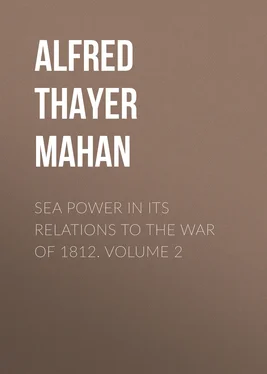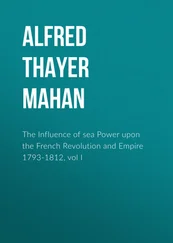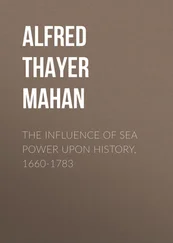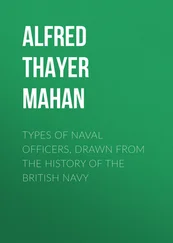Alfred Thayer Mahan - Sea Power in its Relations to the War of 1812. Volume 2
Здесь есть возможность читать онлайн «Alfred Thayer Mahan - Sea Power in its Relations to the War of 1812. Volume 2» — ознакомительный отрывок электронной книги совершенно бесплатно, а после прочтения отрывка купить полную версию. В некоторых случаях можно слушать аудио, скачать через торрент в формате fb2 и присутствует краткое содержание. Жанр: foreign_prose, История, foreign_edu, foreign_antique, на английском языке. Описание произведения, (предисловие) а так же отзывы посетителей доступны на портале библиотеки ЛибКат.
- Название:Sea Power in its Relations to the War of 1812. Volume 2
- Автор:
- Жанр:
- Год:неизвестен
- ISBN:нет данных
- Рейтинг книги:5 / 5. Голосов: 1
-
Избранное:Добавить в избранное
- Отзывы:
-
Ваша оценка:
- 100
- 1
- 2
- 3
- 4
- 5
Sea Power in its Relations to the War of 1812. Volume 2: краткое содержание, описание и аннотация
Предлагаем к чтению аннотацию, описание, краткое содержание или предисловие (зависит от того, что написал сам автор книги «Sea Power in its Relations to the War of 1812. Volume 2»). Если вы не нашли необходимую информацию о книге — напишите в комментариях, мы постараемся отыскать её.
Sea Power in its Relations to the War of 1812. Volume 2 — читать онлайн ознакомительный отрывок
Ниже представлен текст книги, разбитый по страницам. Система сохранения места последней прочитанной страницы, позволяет с удобством читать онлайн бесплатно книгу «Sea Power in its Relations to the War of 1812. Volume 2», без необходимости каждый раз заново искать на чём Вы остановились. Поставьте закладку, и сможете в любой момент перейти на страницу, на которой закончили чтение.
Интервал:
Закладка:
From point to point the mouth of the harbor, where the outer bar occurs, was eight tenths of a mile wide. As shown by a sketch of the period, the distance to be travelled on the floats, from deep water within to deep water without, was a mile; rather less than more. On Monday morning, August 2, the movement of the vessels began simultaneously. Five of the smaller, which under usual conditions could pass without lightening, were ordered to cross and take positions outside, covering the channel; a sixth, with the "Niagara," were similarly posted within. The protection thus afforded was re-enforced by three 12-pounder long guns, mounted on the beach, abreast the bar; distant not over five hundred yards from the point where the channel issued on the lake. While these dispositions were being made, the "Lawrence's" guns were hoisted out, and placed in boats to be towed astern of her; the floats taken alongside, filled, sunk, and made fast, so that when pumped out their rising would lift the brig. In the course of these preparations it was found that the water had fallen to four feet, so that even the schooners had to be lightened, while the transit of the "Lawrence" was rendered more tedious and difficult. The weather, however, was propitious, with a smooth lake; and although the brig grounded in the shoalest spot, necessitating a second sinking of the burden-bearing floats,—appropriately called "camels,"—perseverance protracted through that night and the day of the 3d carried her outside. At 8 A.M. of the 4th she was fairly afloat. Guns, singly light in weight as hers were, were quickly hoisted on board and mounted; but none too soon, for the enemy appeared almost immediately. The "Niagara's" passage was more easily effected, and Barclay offered no molestation. In a letter to the Department, dated August 4, 1813, 9 P.M., Perry reported, "I have great pleasure in informing you that I have succeeded in getting over the bar the United States vessels, the 'Lawrence,' 'Niagara,' 'Caledonia,' 'Ariel,' 'Scorpion,' 'Somers,' 'Tigress,' and 'Porcupine.'" He added, "The enemy have been in sight all day." The vessels named, with the schooner "Ohio" and the sloop "Trippe," constituted the entire squadron.
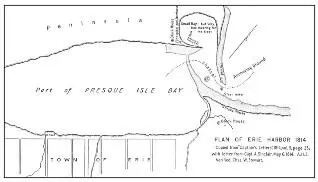
PLAN OF ERIE HARBOR 1814
While Perry was thus profitably employed, Procter had embarked on another enterprise against the magazines on the American front of operations. His intention, as first reported to Prevost, was to attack Sandusky; but the conduct of the Indians, upon the co-operation of whom he had to rely, compelled him to diverge to Fort Meigs. Here the savages began to desert, an attempt to draw the garrison into an ambush having failed; and when Procter, after two days' stay, determined to revert to Sandusky, he was accompanied by "as many hundred of them as there should have been thousands." The white troops went on by water, the Indians by the shore. They appeared before Fort Stephenson on Sunday, August 1. The garrison was summoned, with the customary intimation of the dire consequences to be apprehended from the savages in case of an assault. The American commander, Major Croghan, accepted these possibilities, and the following day, during which the "Lawrence" was working her way over Erie bar, the artillery and the guns of the gunboats were busy battering the northwest angle of the fort. At 4 P.M. an assault was made. It was repelled with heavy loss to the assailants, and little to the besieged. That night the baffled enemy withdrew to Malden.
The American squadron having gained the lake and mounted its batteries, Barclay found himself like Chauncey while awaiting the "General Pike." His new and most powerful vessel, the ship "Detroit," was approaching completion. He was now too inferior in force to risk action when he might expect her help so soon, and he therefore retired to Malden. Perry was thus left in control of Lake Erie. He put out on August 6; but, failing to find the enemy, he anchored again off Erie, to take on board provisions, and also stores to be carried to Sandusky for the army. While thus occupied, there came on the evening of the 8th the welcome news that a re-enforcement of officers and seamen was approaching. On the 10th, these joined him to the number of one hundred and two. At their head was Commander Jesse D. Elliott, an officer of reputation, who became second in command to Perry, and took charge of the "Niagara."
On August 12 the squadron finally made sail for the westward, not to return to Erie till the campaign was decided. Its intermediate movements possess little interest, the battle of Lake Erie being so conspicuously the decisive incident as to reduce all preceding it to insignificance. Perry was off Malden on August 25, and again on September 1. The wind on the latter day favoring movement both to go and come, a somewhat rare circumstance, he remained all day reconnoitring near the harbor's mouth. The British squadron appeared complete in vessels and equipment; but Barclay had his own troubles about crews, as had his antagonist, his continual representations to Yeo meeting with even less attention than Perry conceived himself to receive from Chauncey. He was determined to postpone action until re-enforcements of seamen should arrive from the eastward, unless failure of provisions, already staring him in the face, should force him to battle in order to re-establish communications by the lake.
The headquarters of the United States squadron was at Put-in Bay, in the Bass Islands, a group thirty miles southeast of Malden. The harbor was good, and the position suitable for watching the enemy, in case he should attempt to pass eastward down the lake, towards Long Point or elsewhere. Hither Perry returned on September 6, after a brief visit to Sandusky Bay, where information was received that the British leaders had determined that the fleet must, at all hazards, restore intercourse with Long Point. From official correspondence, afterwards captured with Procter's baggage, it appears that the Amherstburg and Malden district was now entirely dependent for flour upon Long Point, access to which had been effectually destroyed by the presence of the American squadron. Even cattle, though somewhat more plentiful, could no longer be obtained in the neighborhood in sufficient numbers, owing to the wasteful way in which the Indians had killed where they wanted. They could not be restrained without alienating them, or, worse, provoking them to outrage. Including warriors and their families, fourteen thousand were now consuming provisions. In the condition of the roads, only water transport could meet the requirements; and that not by an occasional schooner running blockade, but by the free transit of supplies conferred by naval control. To the decision to fight may have been contributed also a letter from Prevost, who had been drawn down from Kingston to St. David's, on the Niagara frontier, by his anxiety about the general situation, particularly aroused by Procter's repulse from Fort Stephenson. Alluding to the capture of Chauncey's two schooners on August 10, he wrote Procter on the 22d, "Yeo's experience should convince Barclay that he has only to dare and he will be successful." 83 83 Report on Canadian Archives, 1896. Lower Canada, p. 133.
It was to be Sir George's unhappy lot, a year later, to goad the British naval commander on Lake Champlain into premature action; and there was ample time for the present indiscreet innuendo to reach Barclay, and impel him to a step which Prevost afterwards condemned as hasty, because not awaiting the arrival of a body of fifty seamen announced to be at Kingston on their way to Malden.
At sunrise of September 10, the lookout at the masthead of the "Lawrence" sighted the British squadron in the northwest. Barclay was on his way down the lake, intending to fight. The wind was southwest, fair for the British, but adverse to the Americans quitting the harbor by the channel leading towards the enemy. Fortunately it shifted to southeast, and there steadied; which not only enabled them to go out, but gave them the windward position throughout the engagement. The windward position, or weather gage, as it was commonly called, conferred the power of initiative; whereas the vessel or fleet to leeward, while it might by skill at times force action, or itself obtain the weather gage by manœuvring, was commonly obliged to await attack and accept the distance chosen by the opponent. Where the principal force of a squadron, as in Perry's case, consists in two vessels armed almost entirely with carronades, the importance of getting within carronade range is apparent.
Читать дальшеИнтервал:
Закладка:
Похожие книги на «Sea Power in its Relations to the War of 1812. Volume 2»
Представляем Вашему вниманию похожие книги на «Sea Power in its Relations to the War of 1812. Volume 2» списком для выбора. Мы отобрали схожую по названию и смыслу литературу в надежде предоставить читателям больше вариантов отыскать новые, интересные, ещё непрочитанные произведения.
Обсуждение, отзывы о книге «Sea Power in its Relations to the War of 1812. Volume 2» и просто собственные мнения читателей. Оставьте ваши комментарии, напишите, что Вы думаете о произведении, его смысле или главных героях. Укажите что конкретно понравилось, а что нет, и почему Вы так считаете.
